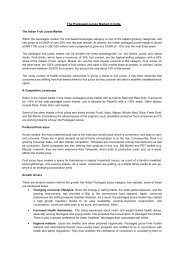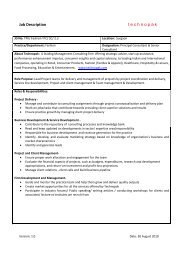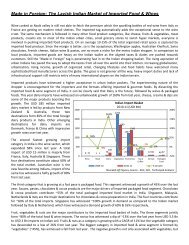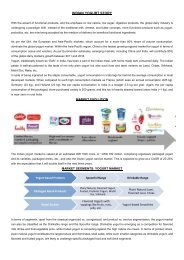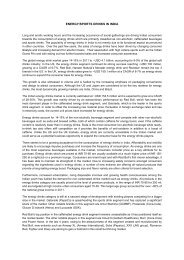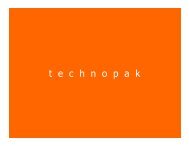Technopak Healthcare Outlook - Vol 4.pdf
Technopak Healthcare Outlook - Vol 4.pdf
Technopak Healthcare Outlook - Vol 4.pdf
Create successful ePaper yourself
Turn your PDF publications into a flip-book with our unique Google optimized e-Paper software.
t e c h n o p a k<br />
Company Name CONFIDENTIAL<br />
1
healthcare<br />
A Q u a r t e r l y R e p o r t b y T e c h n o p a k VOLUME 4<br />
ten<br />
industry<br />
trends:<br />
2008
healthcare<br />
© <strong>Technopak</strong> Advisors Pvt. Ltd.<br />
‘<strong>Healthcare</strong> <strong>Outlook</strong>’, a quarterly feature is an<br />
effort by the <strong>Technopak</strong> <strong>Healthcare</strong> Team to<br />
explore the dynamic changes that are occurring<br />
in the healthcare industry in India today.<br />
We at <strong>Technopak</strong> understand the need for<br />
continuous and intensive assessment of the<br />
world’s largest service sector industry. With<br />
this report we have attempted to provide<br />
insights on the trends and the opportunities in<br />
healthcare market. During the course of this<br />
year we will be publishing reports on various<br />
aspects of the industry with a specific focus<br />
on the diverse opportunities for investment.<br />
c o n t e n t s<br />
Overview 01<br />
TREND 1<br />
Academic Medical Centers<br />
Delivering Excellence in Care, Education & Research 02<br />
TREND 2<br />
<strong>Healthcare</strong> Consumerism in India: Rising Awareness & Spend 03<br />
TREND 3<br />
Newer Formats of <strong>Healthcare</strong> Delivery:<br />
Taking <strong>Healthcare</strong> closer to the consumer 04<br />
TREND 4<br />
<strong>Healthcare</strong> REITS: Addressing the Real Estate challenge 05<br />
TREND 5<br />
Private Equity: The Race for Value Deals 06<br />
TREND 6<br />
Clinical Trials: Making Inroads 07<br />
TREND 7<br />
Emergency Evacuation Services: Building a Network for India 08<br />
TREND 8<br />
<strong>Healthcare</strong> Architecture: The Business of Design 09<br />
TREND 9<br />
<strong>Healthcare</strong> Outsourcing: Providers focus on their core competence 10<br />
TREND 10<br />
Medical Device Innovation : Involving Providers and Physicians 11<br />
About <strong>Technopak</strong> 12
01<br />
Overview<br />
The healthcare sector in India is at the point of inflection in transforming the<br />
delivery setting in terms of the formats, quality of care, affordability and<br />
geographical access. It will be requiring continous effort to take the quantum<br />
leap and design future ready healthcare delivery multi-systems<br />
integrated with comprehensive healthcare financing mechanism, thereby<br />
providing access to majority of the population.<br />
A fast growing economy, rising incomes and increased urbanization have<br />
been instrumental in changing the perception of patients as consumers.<br />
The present day patients are more demanding, expecting better services for<br />
their money and exercising choice in choosing a facility for reasons other<br />
than cost.<br />
India needs an annual incremental addition of healthcare facilities equivalent<br />
to almost half of what UK or France or Italy may need for their entire<br />
population. Against a world average of 3.96 hospital beds per 1000 population,<br />
Russia has 9.7, Brazil has 2.6, China has 2.2, and India languishes at<br />
just over 0.7 indicating the big gap. Just to bring the availability of the beds<br />
to 1.7 per thousand from the current levels it is required to create a million<br />
or more new beds requiring substantial financial investment.<br />
The financial Budget 2008 has given considerable thrust to the health and<br />
social sector and the budget outlay has been considerably increased for<br />
these sectors. Besides the Government has taken initiative to encourage<br />
private sector to establish hospitals in Tier II & Tier III cities by offering 5<br />
year tax holiday beginning fiscal year 2008. It is estimated that around US $<br />
20 billion will be invested in Tier II & Tier III cities in healthcare facilities in the<br />
next 5 years. Clearly indicating that the government is recognizing healthcare<br />
as a priority for nation’s overall progress. Indian healthcare which is US<br />
$ 40 billion industry is expeced to double in the next 5 years to US $ 80<br />
billion.<br />
Academic Medical Centres, AMCs in western world have played a significant<br />
role in research of new drugs and treatments and have emerged as<br />
centres of excellence. Although, India’s contribution to research has been<br />
limited, the country has emerged as the favored destination for clinical trials.<br />
We envisage that AMC in private sector will have a pan India presence and<br />
will evolve as centres of excellence encompassing research, education and<br />
care delivery.<br />
Resource Need Gap in India<br />
Physicians<br />
Medical Colleges<br />
Nurses<br />
Nursing Colleges<br />
Beds<br />
Investments Required<br />
993,500<br />
600<br />
2,510,250<br />
1500<br />
1.1 million<br />
US$ 82 billion investment is required<br />
immediately to make up for the<br />
back-log<br />
An additional US$ 465 billion is<br />
needed to catch up with demographic<br />
shifts as well as improvement<br />
in healthcare indicators in<br />
the next 10 years (i.e. by 2018).<br />
Further additional US$ 500 billion<br />
needed by meet the aging<br />
population’s need by 2028.
Trend 1<br />
Academic Medical Centers<br />
Delivering Excellence in Care,Education & Research<br />
Traditionally medical education set-ups have existed in two forms – stand<br />
alone institutions as well as those that offer research, direct patient care &<br />
education facilities. The latter has an edge over the former, in terms of the<br />
‘exposure’ and ‘quality’ of education imparted. An integrated clinical setting<br />
facilitates high quality delivery of care, better training & cutting edge<br />
research. Such settings also help attract the best talent pool by offering<br />
them a broader perspective to their work.<br />
This synergy is rapidly giving rise to the Academic Medical Centers (AMC)<br />
which are a conglomeration of Medical Research, Education and Patient<br />
Care setting. This comprises of a group of related institutions including a<br />
teaching hospital or hospitals, a medical school and its affiliated faculty<br />
practice plan, and other healthcare professional schools & research<br />
institutes. The tripartite mission of AMC- Education, Research and Patient<br />
Care distinguishes them from peer institutions which are concerned primarily<br />
with one of the three. This international model is now being replicated by<br />
leading private healthcare providers in India.<br />
Considering a huge shortfall of doctors, nurses & paramedics, the healthcare<br />
industry is now actively seeking modifications in the norms for establishing<br />
a medical college; e.g discontiguous use of land, allowing Medical<br />
Collages as corporate entities etc.<br />
• Powerhouses of research, medical education and focused patient<br />
care.<br />
• Enhance sharing of new & proven clinical techniques & knowledge<br />
• Supports the interaction between fundamental and Clinical research<br />
(from bench to bedside)<br />
• Human Resource development<br />
• Attraction & Retention of best talent pool<br />
• Aids Research & Development efforts of Pharmaceutical companies/<br />
CROs.<br />
Leading Academic<br />
Medical Centers<br />
Mayo Clinic<br />
Johns Hopkins<br />
Patient Visits<br />
2006<br />
2,335,000<br />
1,728,617<br />
Medical Manpower<br />
produced annually<br />
Facts at a Glance<br />
Staff Physicians, Medical Scientists and Clinical<br />
Researchers =3,313<br />
Residents, Post Docs and Fellows =2,221<br />
Nurses and another Allied Health staff = 46.656<br />
Medical staff = 4,741<br />
Graduate students, Medical students &<br />
Fellows = 2,692<br />
Registered Nurses = 4,679<br />
Clinical<br />
Programs<br />
Research<br />
Academic<br />
Medical<br />
Centers<br />
The Four Pillars of AMC<br />
The Indian Example<br />
Education<br />
Care<br />
The Manipal Group:<br />
With its strong presence in healthcare delivery,<br />
education & medical research, Manipal<br />
Group is clearly one of the models close to<br />
an AMC model in India. With its strong<br />
academic presence across India and taking<br />
advantage of its huge faculty base, the<br />
group is now extending its leadership from<br />
healthcare delivery and education to the<br />
booming retail sector.<br />
All India Institute of Medical Sciences<br />
(AIIMS):<br />
All India Institute of Medical Sciences has<br />
earned many accolades in healthcare<br />
delivery. Having clinical superspecialties in<br />
the same campus as its major research<br />
facilities makes AIIMS optimally suited for<br />
nurturing best quality translational research<br />
in India.
03<br />
Trend 2<br />
<strong>Healthcare</strong> Consumerism in India<br />
Rising Awareness & Spend<br />
The Indian <strong>Healthcare</strong> Consumer is more evolved and better informed<br />
today. People have started to realize that health needs to be seen as an<br />
important strategic asset, and given the pressures of modern life, physical<br />
and psychological well being are imperatives to doing well at the workplace,<br />
as well as maintaining a harmonious home life.The <strong>Healthcare</strong> market is<br />
now a more competitive marketplace where customer satisfaction is the<br />
watchword.<br />
With rising income and better options to finance healthcare in terms of<br />
health insurance policies, the citizens are catching up faster than ever to<br />
ensure the expenditure that empowers them to choose hospitals. With this<br />
coming into effect, incidences of planned episodes of hospitalization due to<br />
reasons other than doctor referral & proximity in emergency are increasing.<br />
According to India <strong>Healthcare</strong> Trends 2008, a household on an average<br />
spends just above Rs. 4000 as annual expenditure on healthcare.<br />
As per <strong>Technopak</strong> estimates, the average Indian consumers spent out of<br />
wallet on healthcare will be increasing faster (from 7% in 2008 to 13% in<br />
2028).<br />
Main Factors for Choice of Hospitals<br />
It was an emergency so we rushed to this hospital or nursing home<br />
Our regular doctor/specialist/GP aksed us to go this hospital or nursing home<br />
Rising Income<br />
Insurance Coverage<br />
Increasing Awareness<br />
Quality Consciousness<br />
Focus on Preventive Health<br />
37<br />
41<br />
It is one of the hospitals or nursing home listed by the employer or company for health benefits<br />
2<br />
It is one of the hospital or nursing home listed by the medical insurance company<br />
2<br />
Other Reasons<br />
No response<br />
1<br />
17<br />
Main Factor Contributing to Other Reasons (%)<br />
• Good Diagnostic Facilities<br />
• Good Doctors and Specialists<br />
• Good Nursing Care<br />
• Good OT Facilities<br />
• Affordable<br />
0 10 20 30 40 50<br />
3<br />
3<br />
3<br />
2<br />
2<br />
Source: India healthcare treands 2008<br />
<strong>Healthcare</strong><br />
Consumerism<br />
2008<br />
2028<br />
Better Evaluation of Clinical &<br />
Non clinical decisions<br />
Enhance Accountability of Services<br />
by Providers<br />
Quality Improvement & standardization<br />
New <strong>Healthcare</strong> Service Delivery<br />
mechanism
Trend 3<br />
Newer Formats of <strong>Healthcare</strong> Delivery<br />
Taking <strong>Healthcare</strong> closer to the consumer<br />
New retail healthcare formats are gaining traction in India, with affordablecost<br />
walk-in health-care centers for common ailments at one end of the<br />
spectrum, and highly personalized “boutique healthcare” at the other.<br />
Traditionally healthcare has been delivered in a hospital or clinic setting<br />
worldwide. The delivery of modern healthcare has been compartmentalised<br />
based on speciality and location. While this system has its advantage but in<br />
the recent past it has been severly curtailing the access to care. The inflexibity<br />
and inconvenience inherent in obtaining healthcare from only hospital<br />
locations severely restricts consumer choices and consumption.<br />
With the continuing trend towards integration of health and wellness-related<br />
products, the continued emergence and evolution of the health & wellnessconscious<br />
consumer, there has never been a time so ripe in India for hospitals<br />
and healthcare systems to sharpen their focus and innovate their<br />
service offerings.<br />
Delivery Formats<br />
Retail <strong>Healthcare</strong><br />
Medical Malls<br />
Assisted Living<br />
Day Care Surgery Centre<br />
Rehabilitation Centre<br />
Boutique Health Centres<br />
Indian Market Size<br />
US$ Million<br />
Functionality<br />
Basic/primary care medical care<br />
in retail outlets(markets/high streets/malls)<br />
Multiple independent clinics/stores/<br />
centres in a mall set up<br />
Special Residential care (with Medical facilities)<br />
meetng needs of the elderly<br />
Diagnostic & Therapeutic stand alone<br />
intervention centres<br />
Restoring functionality in a convenient<br />
environment<br />
Focus on beauty and wellness<br />
Service Differentiator<br />
Accessibility and convenience<br />
Accessibility & greater depth<br />
of service<br />
Planned facility enabling self<br />
suffuciency & quality of life<br />
Better ambience, high patient<br />
satisfaction & cost effectiveness<br />
Better Accessibility at a lower<br />
cost<br />
Personalised care in an<br />
exclusive environmentllness<br />
Easy Accessibility<br />
Quality Care<br />
DRIVERS<br />
Convenience<br />
Quick Service<br />
RETAIL HEALTHCARE CLINICS are catching<br />
on as a formula for corporate healthcare providers.<br />
Indian Players: Apollo Clinic, Fortis Health<br />
World, Manipal Cure & Care , Reliance<br />
Retail, Wellspring<br />
MEDICAL MALL: A place where all the basic<br />
Health related problems of patients and providers<br />
can be met under a single roof.<br />
An ASSISTED LIVING FACILITY (ALF) are to<br />
provide all day supervision and many other<br />
support services with maximum levels of<br />
privacy, space and dignity.<br />
Indian Players: Golden Nest Senior<br />
Commune (with Ruby Hall Clinic), Dignity<br />
Lifestyle.<br />
DAY CARE SURGERY is now a popular and<br />
preferred mode of treatment for most surgical<br />
patients, where clinically viable.<br />
MEDICAL REHABILITATION deals with<br />
functional restoration of a patient’s normal<br />
physical abilities.<br />
BOUTIQUE HEALTHCARE offers a more<br />
comprehensive “wellness” approach to the<br />
luxury customer.<br />
Indian Players: Fortis <strong>Healthcare</strong> (La<br />
Femme), Apollo Hospitals (The Cradle)
05<br />
Trend 4<br />
<strong>Healthcare</strong> REITS<br />
Addressing the Real Estate challenge<br />
Real Estate Investment Trust (REITs) are corporate, tax-advantaged entities<br />
designed specifically to own and sometimes operate real estate, including<br />
retail properties, apartments, office buildings, and health-care facilities.<br />
REITs were originally formed to provide smaller investors the opportunity to<br />
invest in diversified real estate without directly owning properties and having<br />
to bear any management and operating costs or responsibilities.<br />
Health care REITs specialize in health care facilities, including acute care,<br />
rehabilitation and psychiatric hospitals, medical office buildings, nursing<br />
homes and assisted living centers. REITs do not directly provide health<br />
care services at the properties they own. Rather, REITs rent facilities to<br />
licensed third-party health care providers. By supplying quality health care<br />
facilities and expertise in property management, REITs can help reduce the<br />
burden on providers and facilitate the delivery of medical care.<br />
As estimated, India requires about trillion dollars over a 20 year period and<br />
bulk of the investments would be made by the private sector. High land cost<br />
is a deterrent to many private players investing in healthcare. REITS would<br />
overcome this challenge by unlocking the healthcare delivery value and<br />
would be a key financial instrument in helping healthcare providers.<br />
Characteristics:<br />
• REITs pay no corporate taxes but are required to distribute at least 90<br />
percent of their net taxable income as dividends to shareholders.<br />
• REITs offer operators up to 100 percent financing and an attractive<br />
blended cost of capital, allowing them to fund future growth or distribute<br />
it to shareholders.<br />
• Derive at least 75 percent of gross income from rents or mortgage<br />
interest.<br />
Additional Beds<br />
Required<br />
Bed / 1000<br />
Population Ratio<br />
Floor Space<br />
(800 sq. ft. / bed)<br />
Land Area<br />
(Floor Space Index 1:1)<br />
2008<br />
1.1 million<br />
0.7 to 1.7<br />
880 million sq. ft.<br />
20,000 acres<br />
2018<br />
3.1 million<br />
Anticipated concessions with regards to <strong>Healthcare</strong> REITS:<br />
No tax on Capital Gains under IT Act, 1961<br />
No stamp duty on leases and transfers<br />
Rental Income to be treated on differential basis in the hands of the<br />
recipient.<br />
Rentals in HREITs to be free of Service Tax<br />
HREITs to be exempt from Dividend Distribution Tax<br />
4<br />
2480 million sq. ft.<br />
56,400 acres<br />
2028<br />
2 million<br />
5<br />
1600 million sq. ft.<br />
36,400 acres<br />
REIT<br />
Manager<br />
Sub Contract<br />
Property<br />
Manager<br />
Uniholder<br />
• Cornerstone<br />
(Long Term)<br />
Investors<br />
• Institutional<br />
Investors<br />
• Retail Investors<br />
Investment<br />
in REIT<br />
Units<br />
Ownership of<br />
Assets<br />
Property Management Services<br />
Health Care REIT USA, Inc. is an equity<br />
real estate investment trust (“REIT”) that<br />
invests across the full spectrum of<br />
health care real estate. Founded in<br />
1970, the company was the first REIT to<br />
invest exclusively in health care properties.<br />
It has gross real estate assets of<br />
approximately $5.2 billion and a market<br />
capitalization of approximately $6.5<br />
billion.<br />
Health Care REIT, USA owns:<br />
Assisted Living<br />
Independent Living<br />
Skilled Care<br />
Distributors<br />
Debt<br />
Specialty Care<br />
Lenders / Debt<br />
/ Finance<br />
Principal and<br />
Interest<br />
Acts on behalf<br />
of Uniholder<br />
Medical Office Buildings<br />
REIT Trustee<br />
Net property Income<br />
201<br />
57<br />
234<br />
22<br />
117
Trend 5<br />
Private Equity<br />
The Race for Value Deals<br />
Private Equity investments in India have witnessed significant growth, the<br />
number of deals have increased from $ 7.9 billion in 2006 to $19.03 billion<br />
in 2007.<br />
The healthcare sector attracted over US$ 448 million in year 2007. India<br />
already has an active fund provider base supported by the ICICI Ventures,<br />
one of the largest private-equities, which allocated $250 million for a<br />
dedicated healthcare fund through I-Ven Medicare. Others include IDFC,<br />
HSBC, JP Morgan Private Equity Fund, American International Group Inc.<br />
(AIG), Evolvence India Life Sciences Fund, George Soros's fund Quantum<br />
and BlueRidge. Between 2008 and 2011, the sector is expected to see<br />
investments of around US$ 5 billion.<br />
The healthcare sector in India is witnessing a surge of activity and the beginning<br />
of what is seen as a rapid phase of growth. Emerging healthcare<br />
segments like diagnostic chains, medical device manufactures as well as<br />
hospital chains are increasingly attracting investments from a variety of<br />
venture capitalists. At a broader level, this trend in health care is often seen<br />
as a manifestation of the overall surge in private equity and also growing<br />
interest among private equity funds for Indian companies.<br />
Private equity is smart money because these investors bring more to the<br />
table than just money. The capital and expertise of private equity act as a<br />
catalyst for creating enterprise value.<br />
Sector Wise Value - PE Deals by value<br />
Private Equity Deals for Hospitals<br />
Major <strong>Healthcare</strong> Deals<br />
Apax Partners picked up 12 per cent stake in<br />
Apollo Hospitals Enterprise Ltd for Rs<br />
426.40 crore<br />
ICICI Venture making multiple healthcare<br />
Investments:<br />
• Rs 40 crore in RG Stone Hospital<br />
• Rs 140 crore in Pune's Sahyadri Hospital<br />
• Rs 65 crore in Kolkata's Medica Synergie.<br />
• Rs 96 crore in Mysore’s Vikram Hospital<br />
Narayana Hrudayalaya Pvt Ltd (NHPL) has<br />
sold a 25 per cent stake to the private equity<br />
arms of global financial services firms<br />
American International Group Inc. (AIG) and<br />
JPMorgan for a total consideration of Rs 400<br />
crore ($100 million).<br />
IFC, the private sector arm of World Bank<br />
invested Rs 300 crore in Max <strong>Healthcare</strong>.<br />
India Value Fund infused around Rs 200<br />
crore into Kochi-based DM <strong>Healthcare</strong><br />
Indivision India Partners, private equity fund<br />
of Future Capital Holdings bought 25 per<br />
cent stake in Hyderabad-based Global<br />
Hospitals<br />
UK-based Ashmore Investment Management<br />
Ltd picked up a 19 per cent stake for<br />
Rs 90 crore ($23 million) in CARE group of<br />
hospitals.<br />
Trivitron, received a capital infusion of US<br />
$11 million from HSBC Private Equity (Asia)<br />
Limited and ePlanet, a Global Venture<br />
Capital and Private Equity firm.<br />
MedPlus Hyderabad based Retail<br />
pharmacy chain raised $5.2 million (Rs 23<br />
crore) from iLabs Capital.<br />
Blackstone Group picked up 22% stake in<br />
VLCC at $22 million (Rs 88 crore)
07<br />
Trend 6<br />
Clinical Trials<br />
Making Inroads<br />
The size of the global clinical trials market is today estimated to be over<br />
US$52 billion. The focus of the domestic market is on interventional<br />
treatment trials, in the areas of bio-pharmaceuticals, life sciences & biotechnology.<br />
Globally there are approximately 18000 trials currently being carried out by<br />
more than 1000 contract research organizations, of which around 4 % are<br />
being carried out in India. This is expected to rise to 15% by 2011.<br />
Indian <strong>Healthcare</strong> delivery Provider offer attractive platforms for the Clinical<br />
Research Organizations (CROs). CROs in India are exploring synergies to<br />
establish partnership models with providers to make use of the huge<br />
database, infrastructure and trained human resources. A win – win<br />
paradigm for all stakeholders. This is also leading to a convergence wherein<br />
both CROs & Providers seek opportunities to get into forward / backward<br />
integration themselves. Private equity investments in both sets of organizations<br />
are expected to create further opportunities.<br />
Clinical Trials & Drug Development Process<br />
Phase I trials are<br />
performed to determine<br />
how the drug affects the<br />
human body, how much<br />
medicine is safe and to<br />
determine how the drug<br />
should be administered.<br />
Phase II trials provide<br />
information about how<br />
well a drug works, and<br />
generate more information<br />
on the safety and benefit<br />
of the drug.<br />
PHASE<br />
2<br />
PHASE<br />
4<br />
PHASE<br />
1<br />
PHASE<br />
3<br />
Drug Development<br />
Phase III trials are<br />
held to see if the<br />
current practice is<br />
the best way to treat<br />
a patient, or if a new<br />
drug treatment or<br />
device provides<br />
better treatment.<br />
Phase IV trials are<br />
used to continue<br />
evaluating the drug<br />
after the drug has<br />
received approval to<br />
market them<br />
What’s driving Clinical trials in India?<br />
Availability of highly qualified<br />
manpower<br />
Well established healthcare delivery<br />
mechanism<br />
Low Cost<br />
Easily available and diverse ethnic<br />
subjects for trials<br />
Robust <strong>Healthcare</strong> Information<br />
Technology infrastructure<br />
Clinical Trial Phases Performed in India<br />
Indian Clinical Trials Market<br />
Categories of Players<br />
Pharmaceutical Companies<br />
Contract Research Organizations<br />
Biotechnology Companies<br />
Central Diagnostic Laboratories<br />
Clinical Research Training Institutes
Trend 7<br />
Emergency Evacuation Services<br />
Building a Network for India<br />
Medical studies have firmly established the importance of rapid access to<br />
definitive care. The seriously injured patient has to be attended within one<br />
hour of injury to minimize both mortality and morbidity.<br />
Traditionally medical emergency ambulance services were provided by<br />
hospitals. The range of emergency ambulances vary from land based to air<br />
based vehicles depending upon the need. In today’s scenario many<br />
dedicated Medical Emergency Companies have evolved.<br />
However, in India Emergency Medical Evacuation (EME) is still in it’s<br />
infancy.<br />
Emergency rescue concept in India is increasingly becoming common.<br />
With the concept coming into vogue, constructing a hospital structure with<br />
provision for a helipad in compliance with air safety norms will be an essential<br />
part of new projects.<br />
An air ambulance is an absolute necessty in remote locations and geographies<br />
where there is no access to trauma & speciallsed care facilities.<br />
An increasing number of health insurance plans now cover Emergency<br />
Evacuation Services. This is expected to further fuel the growth of the<br />
sector.<br />
International Players...<br />
National Emergency Number Association (NENA)<br />
United States<br />
Provides nationwide Emergency Number & Promotes 9-1-1<br />
research, planning, training and education. It covers about 99% of<br />
the US population. Receives an estimated 240 million calls are<br />
made to 9-1-1 in the U.S. each year.<br />
The Royal Flying Doctor Service - The first and one of the largest<br />
aero medical organisation in the world.<br />
International SOS - Provider of air ambulance evacuation &<br />
repatriation services across five continents having facilities in<br />
more than 70 countries, including 27 alarm centers and 26 International<br />
SOS clinics.<br />
Medical Emergency Aviation<br />
Air Methods<br />
Indian Players...<br />
Emergency Medical Research Institute (EMRI)<br />
India<br />
Vision is to establish Emergency Research Centre of Excellence by<br />
2010 and is set up in India along similar lines as NENA, with Emergency<br />
Service number: 1-0-8. Till date it has tie-up with more than 400<br />
hospitals across 50 towns, serving 8 Crore population in States AP,<br />
Gujarat, MP. It is set to expand across India by 2010 and employ 1 lakh<br />
people at its proposed 22 emergency response centres operating<br />
through 10,500 ambulances.<br />
East West Rescue<br />
Meera Rescue<br />
Vibha Lifesavers<br />
Trauma constitutes the highest share of<br />
ambulance usage (55%)<br />
Road Accidents<br />
~ 4,40,000 cases<br />
Critical Cases<br />
~ 1,30,000<br />
Deaths<br />
~ 43,800
09<br />
<strong>Healthcare</strong> Architecture<br />
The Business of Design<br />
<strong>Healthcare</strong> delivery settings worldwide are undergoing an accelarated rate<br />
of change with newer emerging trends such as shift to ambulatory care,<br />
development of integrated diagnostic & treatment platforms. In addition,<br />
patients of today can be better seen as consumers who are literally shopping<br />
for healthcare. To respond to this changing health seeking behaviour,<br />
an attendant change in healthcare delivery climate is called for. Facilities<br />
planning and design is one such area that can help achieve new institutional<br />
goals.<br />
Facility design not only helps define patient experience but also improves<br />
the clinical & financial performance of healthcare institutions. It is therefore<br />
imperative to understand the quantifiable benefits of good design. Evidence<br />
based design is an emerging concept which uses measurable delivery<br />
outcomes to create environments that are therapeutic, supportive of family<br />
involvement, efficient for staff performance and restorative for workers in<br />
addition to supporting a sustainable design. It is seen, for instance, that<br />
single room inpatient accommodation leads to faster recovery and<br />
improved clinical performance. Given these indirect benefits, the added<br />
expenditure in creating 100% single rooms is insignificant as illustrated<br />
below.<br />
A well designed facility may require a higher initial outlay, however, there are<br />
significant compensatory savings & cost avoidance in the long run making<br />
good design a sound business proposition.<br />
Single Room vs. Multi bed : Cost Dynamics<br />
Assumptions:<br />
Increase in floor area/bed = 50 sq. ft<br />
For 300 bed hospital = 15,000 sq. feet<br />
Cost of construction @ Rs. 3000/sq ft<br />
Increase in Capital expenditure = 4.5 crore<br />
This results in a maxmim 5 % increase in overall capital expenditure<br />
Advantages<br />
of EBD<br />
Trend 8<br />
Clinical Outcome<br />
Financial Outcome<br />
Other Benefits<br />
Parameters<br />
Architectural Responses<br />
• Acuity adaptable single rooms<br />
• Separation of Inpatient and Outpatient<br />
•Decentralized design<br />
•Patient room layout<br />
•Equipment integration<br />
•Decentralized logistical support<br />
•HEPA filters<br />
•Adequate hand-washing facilities<br />
•Provision for family stay/involvement in<br />
care delivery<br />
•Value added services<br />
For Patients For Institutions For Community<br />
Reduced Patient Falls<br />
Reduced Medical Errors<br />
Reduced Nosocomial Infections<br />
Increased Market share<br />
Attracts more philanthropic donations<br />
Reduced staff turnover<br />
Reduced use of drugs<br />
Reduced Length of patient stays<br />
Enhanced staff productivity & performance<br />
•Daylight, art, landscape, music<br />
•Adaptable services planning<br />
Physical Design<br />
Human Resource<br />
Re engineering<br />
Better quality of life<br />
DRIVERS<br />
Operations<br />
Re engineering<br />
Logistics System<br />
Design
<strong>Healthcare</strong> Outsourcing<br />
Providers focus on their core competence<br />
With changing <strong>Healthcare</strong> market dynamics, the providers are under greater<br />
pressure to provide cost effective quality services. In an effort to do so, they<br />
prefer to focus focus on their core domain of Medical delivery. This has led<br />
to a plethora of outsourcing companies which focus on the support services<br />
in a hospital.<br />
Due to an increasing inclination of providers towards organized contractors,<br />
the current estimated market size of more than US$ 1 billion is expected to<br />
grow at a CAGR of 20%.<br />
The main reasons for outsourcing of services include functional and industry<br />
specialization, cost & technology consideration. The outsourcing providers<br />
are today offering a wide array of highly sophisticated speciallsed<br />
services at an affordable cost to the provider. In turn the contractors get a<br />
larger market share making the arrangement mutually beneficial.<br />
Components<br />
Cost Centre<br />
Revenue Centre<br />
Both<br />
Trend 9<br />
Various Models of Outsourcing<br />
Market Distribution<br />
Model<br />
Fixed Cost +<br />
Incentive<br />
Profit Sharing;<br />
Revenue Sharing<br />
Fixed Cost +<br />
Profit Share +<br />
Incentive<br />
Example<br />
Housekeeping, Security, Laundry<br />
Food & Beverages, Parking, Transportation<br />
Radiology & Pathology Services<br />
Source: India <strong>Healthcare</strong> Treands 2008<br />
Hospital Outsourcing Market<br />
Major Consideration for Outsourcing<br />
•Make vs. Buy – Own vs. Rent –<br />
Manage vs. Outsource…<br />
•Unique Skill Sets<br />
•Complex Processes<br />
•Technology Limitation<br />
•Cost Benefit Analysis<br />
Emerging Areas of Outsourcing<br />
• Information Technology<br />
• Food & Beverages<br />
• Recruitment & Training of Manpower<br />
• Hospital Management<br />
• Financial Accounting<br />
• Ambulance Services<br />
• Facility Management<br />
• Biomedical Equipment Maintenance<br />
Cost<br />
Non-Core<br />
Areas<br />
Technology<br />
<strong>Healthcare</strong><br />
Outsourcing<br />
Market<br />
Competition<br />
Vendor Specialized<br />
Services<br />
Labor<br />
Problems
11<br />
Trend 10<br />
Medical Device Innovation<br />
Involving Providers and Physicians<br />
India is seen as a worldwide hub for technology innovations on the similar<br />
lines of automobile manufacturing industry. Medical Device Innovation<br />
starts with an idea followed by applied research to validate the idea. The<br />
next stage is the development of a new medical device starting with a<br />
patent, followed by prototyping, clinical trials & Food & Drug Administration<br />
(FDA) approval.<br />
Research & Development plays a very significant role in Medical device<br />
innovation and Physicians & Providers play a crucial role in this process.<br />
Role of Providers & Physicians- Major Highlights<br />
• Medical technology innovation typically consists of incremental improve<br />
ments to existing technologies. Such innovation takes place everyday,<br />
through interaction amongst companies, physicians, patients and others.<br />
• The medical technology innovation process is interactive and involves<br />
significant collaboration with physicians and other end users. Real-world<br />
experiences with a product, both positive and negative, are critical to the<br />
design of the next generation of a given technology.<br />
• Clinical outcomes, patient and physician preferences and other after-<br />
market data are collected continually by medical technology firms to<br />
improve the next generation of a device.<br />
Medical Device Innovation Process<br />
Applied<br />
Research<br />
Targeted<br />
Development<br />
Product Patent<br />
& Prototyping<br />
Clinical Trials &<br />
FDA Approval<br />
Manufacturing<br />
& Marketing<br />
Adoption<br />
& Use<br />
Medical technology & Pharmaceutical Companies<br />
spend 12% of their revenue on<br />
Research & Development, which is significantly<br />
higher than other industry.<br />
Medical Device Clinical Trials in India<br />
India provides a suitable destination for<br />
medical device companies. The two<br />
major factors responsible for supporting<br />
clinical trial studies in India are:<br />
• The cost of conducting clinical trials in<br />
India is about 40-60% less than in<br />
western countries.<br />
• Recruitment of patients for clinical trials<br />
results in reduced time to market a new<br />
device.<br />
Medical Device Companies & <strong>Healthcare</strong> Providers Presently doing Medical Device Clinical Trials in India<br />
Abbott Apollo Hospitals<br />
Johnson & Johnson EHIRC<br />
Aurolab Fortis <strong>Healthcare</strong><br />
Medtronics Max <strong>Healthcare</strong><br />
Codman & Shurtliff AIIMS<br />
Pro Top & Mediking Aravind Eye Hospital<br />
Global Medical Device R&D Market<br />
Source: www.clinical trials.gov
About <strong>Technopak</strong><br />
With a team of established domain experts at work, <strong>Technopak</strong> builds and<br />
enhances business capabilities for leading Indian and international companies<br />
by offering end-to-end services that are unique thanks to our rich experience,<br />
strong industry relationships and a global footprint.<br />
<strong>Technopak</strong>’s services are built around offering integrated strategy, process<br />
and technology deployment solutions to clients. Our key sectors of focus<br />
include Textile & Apparel, Retail & Consumer Goods, Consumer Insights,<br />
<strong>Healthcare</strong> and Hospitality.<br />
The healthcare practice is uniquely positioned to advice clients based on its<br />
expertise in the Indian Scenario, insight into consumer behavior in India and<br />
its access to the best international practices.<br />
The <strong>Healthcare</strong> Practice provides the whole gamut of services from concept<br />
to commissioning for the healthcare delivery chain.<br />
Strategic & Business Consulting<br />
Facility Planning & Architectural Design<br />
Medical Equipment Planning<br />
Human Resource Management<br />
Operations Optimization<br />
Quality & Accreditation support<br />
Marketing & Branding<br />
Information Technology<br />
Health Education & Training<br />
Public Health<br />
Mergers & Acquisition Support<br />
CONTACTS<br />
Dr. Rana Mehta<br />
Vice President, <strong>Healthcare</strong><br />
rana.mehta@technopak.com<br />
Gulshan Baweja<br />
Principal Consultant, <strong>Healthcare</strong><br />
gulshan.baweja@technopak.com<br />
Monika Kejriwal<br />
Principal Consultant, <strong>Healthcare</strong><br />
monika.kejriwal@technopak.com<br />
Abhishek Pratap Singh<br />
Principal Consultant, <strong>Healthcare</strong><br />
abhishek.singh@technopak.com<br />
<strong>Healthcare</strong> Practice<br />
<strong>Technopak</strong> Advisors Pvt. Ltd.<br />
4th Floor, Tower A<br />
Building-8<br />
DLF Cyber City, Phase-II<br />
Gurgaon-122002<br />
(National Capital Region of Delhi)<br />
India<br />
T: +91 124 4541111<br />
F: +91 124 4511198/99<br />
Email: healthcare@technopak.com<br />
Website: www.technopak.com
Head Office<br />
4th Floor, Tower A, Building 8, DLF Cyber City, Phase II,<br />
Gurgaon 122 002, (National Capital Region of Delhi)<br />
T: +91-124-454 1111, F: +91-124-454 1199<br />
Bangalore<br />
11A, 11th Floor, Canberra Block, U B City<br />
24, Vittal Mallya Road, Bangalore 560 001<br />
T: +91-80-4034 8600, F: +91-80-4034 8699<br />
Mumbai<br />
101-105, 2nd Floor, Sunjana Tower,<br />
Sun Magnetica Service Road,<br />
Luis Wadi, Thane West,<br />
Mumbai 400 602<br />
T: +91-22-2583 2222, F: +91-22-2583 8408<br />
healthcare<br />
For further details, please contact:<br />
Dr. Rana Mehta<br />
Vice President, <strong>Healthcare</strong><br />
rana.mehta@technopak.com
t e c h n o p a k<br />
Company Name CONFIDENTIAL<br />
35
t e c h n o p a k<br />
Company Name CONFIDENTIAL<br />
36



